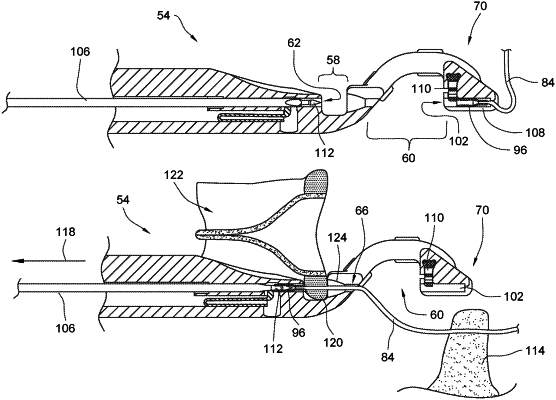| CPC A61B 17/0469 (2013.01) [A61B 17/0482 (2013.01); A61B 2017/0406 (2013.01); A61B 17/0487 (2013.01); A61F 2/2409 (2013.01)] | 21 Claims |

|
1. A suturing device comprising:
a housing;
an actuator coupled to a first portion of the housing such that the actuator is displaceable between a first actuator position and a second actuator position;
a shaft extending from a proximal end to a distal end along a shaft axis, wherein the shaft defines an interior portion that extends from the proximal end of the shaft to the distal end of the shaft, and wherein the proximal end of the shaft is coupled to a second portion of the housing;
a needle extending from a proximal end to a distal end along a longitudinal axis that is parallel to or coaxially aligned with the shaft axis, wherein the proximal end of the needle is coupled to a portion of the actuator and at least a portion of the needle extends through the interior portion of the shaft, wherein as the actuator is displaced from the first actuator position to the second actuator position, the distal end of the needle is displaced along the longitudinal axis from a first needle position to a second needle position, and wherein as the actuator is displaced from the second actuator position to the first actuator position, the distal end of the needle is displaced along the longitudinal axis from the second needle position to the first needle position; and
a guide tip coupled to the distal end of the shaft, the guide tip comprising:
a proximal portion;
a transition portion coupled to the proximal portion, wherein a transition passage extends through the transition portion from a proximal end of the transition portion to a distal end of the transition portion;
a distal portion coupled to the transition portion, the distal portion having a first ferrule receiving passage, wherein a first ferrule receiving aperture is disposed at a proximal end of the first ferrule receiving passage, and wherein at least a portion of the first ferrule receiving passage is configured to hold a first ferrule secured to a first portion of suture;
a first slot defined between a distal end of the proximal portion and the proximal end of the transition portion, the first slot defining a cuff receiving area configured to receive a portion of a first material; and
a second slot defined between the distal end of the transition portion and a proximal end of the distal portion, the second slot defining a tissue bite area configured to receive a portion of second material,
wherein in the first needle position, the distal end of the needle is disposed proximal to the distal end of the proximal portion and in the second needle position, the distal end of the needle is disposed adjacent to the first ferrule receiving aperture of the distal portion such that the distal end of the needle is configured to operatively engage the first ferrule secured to the first portion of suture, and
wherein as the needle displaces from the first needle position to the second needle position, the distal end of the needle displaces through a portion of the cuff receiving area, the transition passage, a portion of the tissue bite area, and a proximal portion of the first ferrule receiving passage, and
as the needle displaces from the second needle position to the first needle position, the distal end of the needle is configured to retain the first ferrule secured to the first portion of suture as the distal end of the needle displaces through the proximal portion of the first ferrule receiving passage, the portion of the tissue bite area, the transition passage, and the portion of the cuff receiving area, and
wherein a first longitudinal distance between the distal end of the proximal portion and the proximal end of the transition portion is less than a second longitudinal distance between the distal end of the transition portion and the proximal end of the distal portion.
|